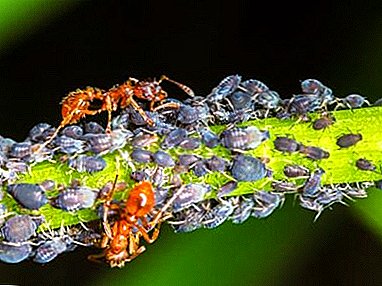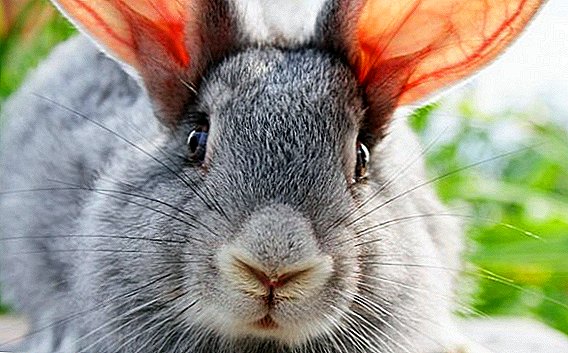 Many people who keep rabbits at home notice that something is wrong with their eyesight. They do not see food right in front of them, they absolutely do not react to the owner, as if meeting him for the first time. Of course, in such cases, breeders are interested in whether everything is in order with the animals or problems arise due to the anatomical features of his vision. For those who want to get an answer, we suggest reading our article.
Many people who keep rabbits at home notice that something is wrong with their eyesight. They do not see food right in front of them, they absolutely do not react to the owner, as if meeting him for the first time. Of course, in such cases, breeders are interested in whether everything is in order with the animals or problems arise due to the anatomical features of his vision. For those who want to get an answer, we suggest reading our article.
Rabbit eyes
So, we will understand how the eyes of a rabbit are arranged and what is the peculiarity of the view of this animal.
Structural features
The eyeball of a rabbit is large, in the form of a ball. Its structure is identical to the structure of the eyeball of many other animals. It is located in the orbit and is connected to the brain with the help of the optic nerve.
The insides of the eyeball are light refracting media (lens, vitreous body, the contents of the anterior and posterior chambers), the membranes and nerves with vessels.
You will probably be interested to learn more about the anatomy of a rabbit.
The eyeball covers 3 centuries. This is the traditional upper and lower, as well as another eyelid, which is located in the inner corner of the eye. The third eyelid is necessary to protect the sebaceous gland.
The lacrimal gland is located in the temporal corner of the eye. For the movement of the organs of vision 7 muscles are responsible: 4 straight, 2 oblique and 1 retractor of the eyeball. On the surface of the eye is a thick plaque, which helps to moisturize and preserve the apple. Thanks to this raid, rabbits blink quite rarely. 
What color are
The colors of the iris in rabbits may be different. In purebreds, they often harmonize with the color of fur, they are blue, brown, dark brown, light brown, red, gray, green, blue, gray-blue. The color of the eyes of an animal belonging to any breed must comply with the stated standard.
So, for the Angora breed, red and blue irises are characteristic, for the black-fiery breed - brown, and in the presence of a blue back - blue. For flandre, the iris is brown, for representatives of Alaska - dark brown, for "Californians" and "New Zealanders" - from light pink to red, for Vienna blue - dark blue.
Important! A purebred rabbit needs to be purchased only from a trusted breeder or in a pet store with a good reputation. When buying, you should pay attention to the compliance of animal parameters with the standard, including eye color.The ram breed often has irises of different colors, dominated by brown and blue. Albino iris always red. Butterfly breed has eyes of the same shade as dark spots on the body, while representatives of the breed of squirrels have colored shades of gray. Please note that iris pigmentation may change during the first months after birth.

How do rabbits see
Rabbits are born blind. Their eyes open only when they reach 10-14 days of age. The crawl has monocular vision. This means that the animal examines objects that are in his field of view with one eye.
Monocular vision is measured in the corners. Eared is able to inspect the area around him at 360 °. The field of view of the right and left eye is stratified on the front by 27 ° and behind by 9 °. Since the eyes of this rodent are located on the sides, it can see a lot around, but, alas, is not able to see what is in front of his nose.
If the rabbit is looking forward, then the area in front is for him the so-called "blind zone." Therefore, in order to consider objects that are in this area, the crawl must turn its head.
Such a structure of the visual apparatus in rabbits is adapted for self-preservation. The animal can be seen from a distance and in a wide radius of an approaching enemy and have time to hide from it in time.
Important! In rabbits, eye diseases can often occur. For symptoms such as heavy tearing, conjunctival discharge, sticking and swelling of the eyelids, clouding of the lens, itching, fear of light, loss of vision, you should contact your veterinarian for diagnosis and prescription of a competent treatment.
It is believed that the eyesight of rabbits is color. This, in particular, speaks of studies conducted in the 70s of the last century, during which it was proved that rodents distinguish between 2 colors - blue and green. However, some researchers believe that this is not the case, arguing that these animals can achieve the differentiation of some colors using the method of conditioned reflexes. 
Do rabbits see in the dark?
The rabbit has excellent vision in both day and night time. However, he sees not like a person - his picture is more blurred, not so clear. For example, it is believed that the animal sees its owner in the form of a large spot. Therefore, if a person picks up a large object that covers part of his body, then the rabbit will not recognize it, since the outlines of the host will be of a different shape that is not familiar to him.
Crawls often are nocturnal, so they can eat well in complete darkness and indulge in other things when there is no light. For their vision, there is almost no difference - it is light now or dark. The rodent always feels comfortable and safe.
The wise nature has endowed rabbits with this peculiarity due to the fact that they live in burrows under the ground (they sleep there, hide from danger and nurse their offspring), and their greatest activity falls on twilight time and early morning.
Find out why the rabbit grit its teeth and does not eat, why the rabbit tears down, why the rabbit became sluggish and does not eat, why the rabbit bites, and also why the rabbit grunts when breathing through its nose.
But despite the fact that rabbits are well-versed in the dark, it is still not worthwhile to leave them without light for a long time. The lack of coverage provokes a decrease in productivity, as well as a delay in the development and growth of young stock. 
Are you sleeping with your eyes open or not?
Rabbits sleep with their eyes narrowed slightly, their eyelids do not close up completely. These rodents are very shy, so with every noise or movement, they immediately wake up. Although if animals live in an apartment for a long time, where nothing extraordinary happens, they become accustomed to peace of mind and may fall asleep in a deep sleep, during which their eyes are almost closed. They love to sleep, huddled in a corner or lounging in a cage.
Did you know? Despite some external similarity and assignment to one family, rabbits have clear differences from hares. The main ones are the fact that bunnies are born blind and bald, and hares are covered with hair and with open eyes that they see. Another significant difference at that rabbits live in underground holes, and hares - in ground nests. And hares, unlike rabbits, could not be tamed.
Monocular type of vision has a number of pros and cons. The first is a good overview of almost 360 ° and the ability to notice a predator from afar. The main disadvantages are the inability to see objects directly in front of the animal’s nose, as well as the lack of clarity of the image.
Therefore, the owner of a rodent should not be surprised if his pet does not respond to the feeder placed directly in front of him. To he noticed her, you should place the tray on the left or right of the animal's head. So, a rabbit breeder should know that the sight of these animals is arranged in a special way.  It allows the rodent to evaluate objects with one eye, and is completely different, for example, from the cat or dog. Birds and horses also have monocular vision.
It allows the rodent to evaluate objects with one eye, and is completely different, for example, from the cat or dog. Birds and horses also have monocular vision.
Did you know? For the title of the biggest rabbit in the world 2 males compete - Ralph and Darius. The first at 4 years old reached a weight of 25 kg and a length of 130 cm. The second one had the same height and weighed just over 22 kg.For a complete perception of the surrounding world, rabbits, except the eyes, use the nose and mustache, as well as the ears. Therefore, what is located in front of them in the "blind zone", they find with the help of smell and touch, and not sight.












